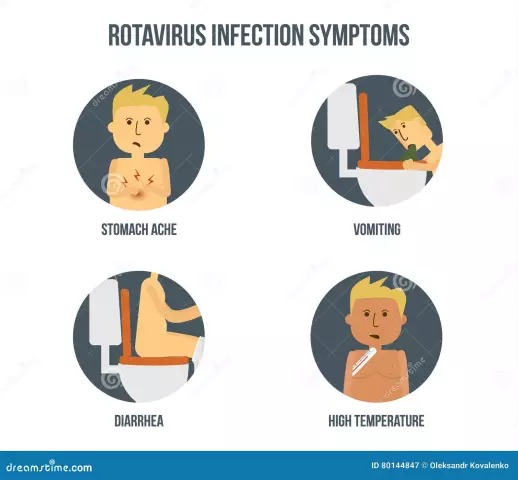- Author Curtis Blomfield [email protected].
- Public 2023-12-16 20:44.
- Last modified 2025-01-23 17:01.
Meningitis is a disease that most often occurs in childhood, when infections (virus, bacteria, fungus) are easiest to overcome the protective barriers that protect the brain, provoke inflammation on the shell closest to it. More often, the disease occurs in children born with brain pathology (hydrocephalus, cerebral palsy, intrauterine brain damage by cytomegalovirus or Epstein-Barr virus), as well as in premature babies. Babies who have a congenital defect in any of the links of immunity are also much more likely to suffer meningitis. Signs y

children of this disease have some differences (compared to adults).
Where does meningitis come from?
The disease in a child can develop as a complication of purulent otitis, rhinitis, sinusitis, sinusitis (secondary meningitis, signs in children of which must be carefully monitored if the child suffers such a disease). There is a variant of the development of meningitis as a complication of viral diseases, such as measles, SARS, chicken pox, rubella, mumps,enterovirus infection. The most dangerous is meningococcal meningitis, which can be contracted:
- from a microbe carrier (that is, a person who feels he althy);
- from an adult or child with meningococcal nasopharyngitis (red throat and purulent discharge from the nose, accompanied by a rise in temperature for 1-3 days);
- from a patient in whom this bacterium caused inflammation of the lining of the brain.
This meningitis is the most dangerous. Its incubation period is 2-3 days. Then symptoms appear, one of the characteristic signs of which is a hemorrhagic rash, described below.

How does meningitis manifest in children?
Children, like adults, can say that they have a headache. Also, parents notice that the child has a fever. But if the baby is not yet talking, how can you suspect meningitis? Signs in children of this disease are:
1. The child becomes more lethargic, sleepy.
2. Vomiting may occur, regardless of food intake.
3. Increased body temperature.
4. In infants, you can notice the swelling of a large fontanelle (normally, it is located on the same level with the bones of the skull).
5. The child adopts an elongated position in bed, often throwing his head back.
6. Reacts negatively to bright lights, loud noises, music.
7. Refuses to eat, sleepy.
8. There may be convulsions with impaired consciousness and respiratory arrest at any (even up to 38degrees) body temperature.
9. If you lift the baby by the armpits, he will pull the legs to the chest.

10. With meningococcal and some other meningitis, a dark rash appears on the body (primarily on the buttocks and legs). It can be purple, brown, dark red. Its characteristic feature is that if you press on the stain with a transparent container (glass, jar) or glass, it does not turn pale. This means that the skin in this place is soaked with blood.
A rash with such characteristics acquires a tendency to merge with each other, as well as to the appearance in some places of necrosis (death) of the skin and underlying tissues.
If you see any suspicious rash, especially against the background of an increase in body temperature, urgently call an ambulance. Even if it is not meningitis, signs in children of such a nature as a rash are a reason for hospitalization and treatment in an infectious diseases hospital.






